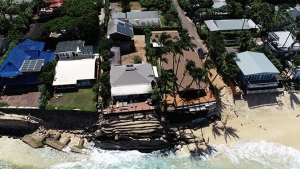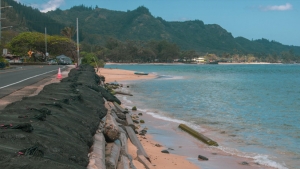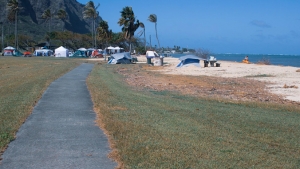The reactive and piecemeal approach historically used to manage beaches in Hawaiʻi has failed to protect them, according to a new study by researchers in the Coastal Geology Group at the University of Hawaiʻi at Mānoa School of Ocean and Earth Science and Technology (SOEST). The study also found that if policies are not changed, as much as 40 percent of all beaches on Oʻahu could be lost before mid-century.
In an era of rising sea-level, beaches need to migrate landward, otherwise they drown. Beach migration, also known as shoreline retreat, causes coastal erosion of private and public beachfront property. Shoreline hardening, the construction of seawalls or revetments, interrupts natural beach migration—causing waves to erode the sand, accelerating coastal erosion on neighboring properties, and dooming a beach to drown in place as the ocean continues to rise.



The team of scientists, led by graduate researcher Kammie Tavares in SOEST’s Department of Earth Sciences, assessed the shoreline around Oʻahu that would be most vulnerable to erosion under three scenarios of sea-level rise—all estimated to occur around mid-century.
Shoreline hardening and beach loss
They identified the location and severity of risk of shoreline hardening and beach loss, and a potential timeline for the increase in erosion hazards. The most threatened properties fall into an “administrative erosion hazard zone,” an area likely to experience erosion hazards and qualify for the emergency permitting process to harden the shoreline.
“By assessing computer models of the beach migration caused by 9.8 inches (0.25 meters) of sea-level rise, an amount with a high probability of occurring before mid-century, we found that emergency permit applications for shoreline hardening to protect beachfront property will substantially increase,” said Tavares.
According to co-author Tiffany Anderson, assistant researcher in the Department of Earth Sciences, “We determined that almost 30 percent of all present-day sandy shoreline on Oʻahu is already hardened, with another 3.5 percent found to be so threatened that those areas qualify for an emergency permit today. Our modeling indicates that, as sea-level rises about 10 inches (0.25 meters) by mid-century, an additional nearly eight percent of sandy shoreline will be at risk of hardening—meaning at that point, nearly 40 percent of Oʻahu’s sandy beaches could be lost in favor of hardened shorelines.”
“In another study published in 2018, we showed that accelerated erosion on neighboring properties, called flanking, usually leads to additional shoreline hardening, and condemns entire beaches,” said co-author Chip Fletcher, associate dean and professor in SOEST. “It is clear that management decisions made today, and during the careers of most of today’s natural resource managers, will be critical in determining if future generations will inherit a healthy shoreline, or one that has been ruined by seawalls, and other types of shoreline hardening.”
Continue reading on SOEST‘s website.
–By Marcie Grabowski

